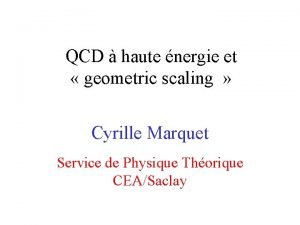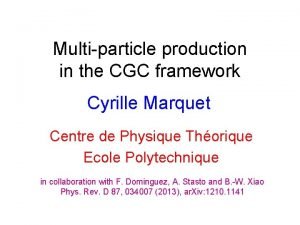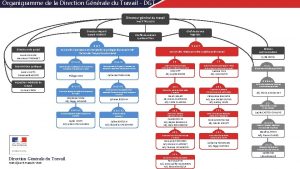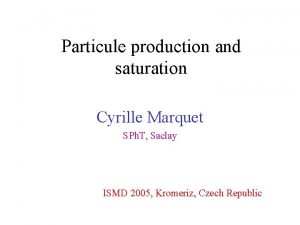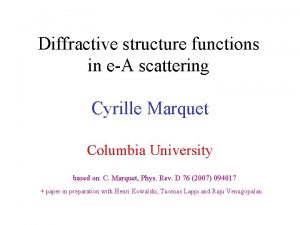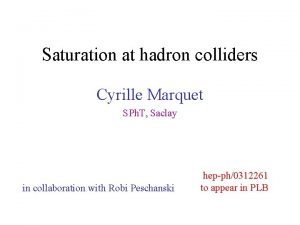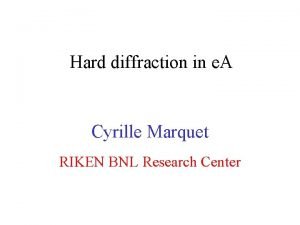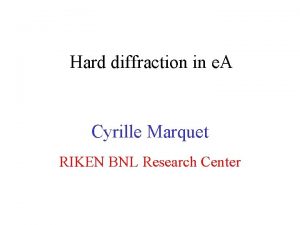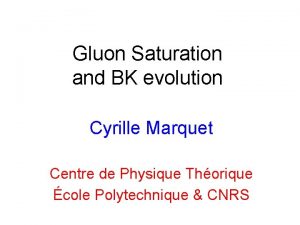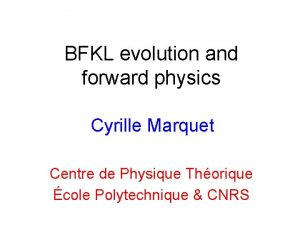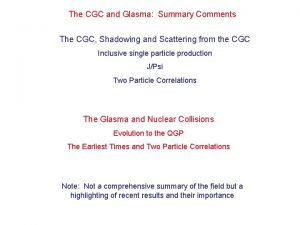Multiparticle production in the CGC framework Cyrille Marquet















- Slides: 15

Multi-particle production in the CGC framework Cyrille Marquet Centre de Physique Théorique Ecole Polytechnique in collaboration with F. Dominguez, A. Stasto and B. -W. Xiao Phys. Rev. D 87, 034007 (2013), ar. Xiv: 1210. 1141

Map of parton evolution in QCD x : parton longitudinal momentum fraction k. T : parton transverse momentum the distribution of partons as a function of x and k. T : QCD linear evolutions: DGLAP evolution to larger k. T (and a more dilute hadron) BFKL evolution to smaller x (and denser hadron) dilute/dense separation characterized by the saturation scale Qs(x) QCD non-linear evolution: meaning this regime is non-linear yet weakly coupled: collinear factorization does not apply when x is too small and the hadron has become a dense system of partons parton density partonic cross-section higher twist

The Color Glass Condensate • the CGC wave function valence partons as static random color source small x gluons as radiation field CGC wave function separation between the long-lived high-x partons and the short-lived low-x gluons classical Yang-Mills equations in the A+=0 gauge • the small-x evolution the evolution of the solution gives from , one can obtain the unintegrated gluon distribution, as well as any n-parton distributions with x is a renormalization-group equation Jalilian-Marian, Iancu, Mc. Lerran, Weigert, Leonidov, Kovner (1997 -2002)

Scattering off the CGC • this is described by Wilson lines scattering of a quark: dependence kept implicit in the following in the CGC framework, any cross-section is determined by colorless combinations of Wilson lines , averaged over the CGC wave function • the 2 -point function or dipole amplitude the dipole scattering amplitude: or this is the most common Wilson-line average x : quark transverse coordinate y : antiquark transverse coordinate

The dipole scattering amplitude a fundamental quantity to study high-energy scattering in QCD • deep inelastic scattering at small x : overlap of splitting functions r = dipole size dipole-hadron cross-section computed in the CGC resums powers of g. S A and powers of αS ln(1/x. B) • particle production at forward rapidities: r = z-z’ dipole-hadron scattering amplitude (adjoint or fundamental) FT of dipole amplitude ≡ unintegrated gluon distribution p p

Di-hadron production and quadrupole evolution

Forward di-hadron production in p+A type collisions CM (2007) the saturation regime is better probed compared to single particle production is sensitive to multi-parton distributions, and not only to the gluon distribution the CGC cannot be described by a single gluon distribution no k. T factorization involves 2 -, 4 - and 6 - point functions

The two-particle spectrum b: quark in the amplitude x: gluon in the amplitude b’: quark in the conj. amplitude x’: gluon in the conj. amplitude collinear factorization of quark density in deuteron Fourier transform k┴ and q┴ into transverse coordinates p. QCD q → qg wavefunction interaction with target nucleus n-point functions that resums the powers of g. S A and the powers of αS ln(1/x. A)

2 - 4 - and 6 -point functions the scattering off the CGC is expressed through the following correlators of Wilson lines: if the gluon is emitted before the interaction, four partons scatter off the CGC if the gluon is emitted after the interaction, only the quarks interact with the CGC interference terms, the gluon interacts in the amplitude only (or c. c. amplitude only) in the large Nc limit, everything is expressed in terms of dipoles and quadrupoles

Dealing with the 4 -point function • in the large-Nc limit, the cross section is obtained from and the 2 -point function is fully constrained by e+A DIS and d+Au single hadron data • in principle the 4 -point function should be obtained from an evolution equation (equivalent to JIMWLK + large Nc) Jalilian-Marian and Kovchegov (2005) • in practice one uses an approximation that allows to express C. M. (2007) S(4) as a (non linear) function of S(2) this approximation misses some leading-Nc terms they may become dominant for Dumitru and Jalilian-Marian (2010) Dominguez, Xiao and Yuan (2010) • very recent results: 4 -point function obtained from a numerical solution of the JIMWLK equation Dumitru, Jalilian-Marian, Lappi, Schenke and Venugopalan (2011) the so-called dipole approximation used in the calculation show ~10% deviations

Di-hadron angular correlations comparisons between d+Au → h 1 h 2 X (or p+Au → h 1 h 2 X ) and p+p → h 1 h 2 X p+p collisions Df=0 (near side) central d+Au collisions Df=p (away side) Albacete and CM (2010) (rad) ~p however, when y 1 ~ y 2 ~ 0 (and therefore x. A ~ 0. 03), the p+p and d+Au curves are almost identical

Multi-particle production in the large-Nc limit

From n to n+1 particles produced • assume the cross section for the production of n partons is made of only dipoles and quadrupoles • then one can show that the cross section for the production of n+1 partons is also made of only dipoles and quadrupoles gluon line added between two different objects does not increase the total number of color traces (loops in the diagramatic representation) therefore these contributions will be subleading in Nc (they do involve higher-point functions) gluon line added within same object Dominguez, CM, Stasto and Xiao (2013) this will provide the leading-Nc terms

From n to n+1 particles produced • gluon line added within the same objects if the extra gluon interacts both in the amplitude and in the conjugate amplitude this adds a quadrupole to the expression for the n-parton cross section if the extra gluon interacts only in the amplitude (or in the conjugate amplitude) this adds a dipole to the expression for the n-parton cross section if the extra gluon interacts in neither the amplitude or the conjugate amplitude this splits a quadrupole into two dipoles (or adds a Nc factor to a dipole) • other case to consider q-qbar pair added to n-1 partons

Conclusions • Non-linear small-x evolution well established for dipoles - cornerstone: the Balitsky-Kovchegov equation - running-coupling corrections necessary for phenomenology • The non-linear evolution of the quadrupole - brought to our attention by recent di-hadron correlation measurements - so far the phenomenology relies on (too many? ) approximations • Large-Nc limit: dipoles and quadrupoles sufficient for multi-particle production in p. A collisions - worth to put some effort to accurately solve the quadrupole evolution - need data to constrain the initial condition (e. g. p+Pb at the LHC)
 Cyrille marquet
Cyrille marquet Cyrille marquet
Cyrille marquet Alur post
Alur post Cgc minerals
Cgc minerals Cgc bank
Cgc bank Albert marquet fauvismo
Albert marquet fauvismo Vania jess y cyrille
Vania jess y cyrille Organigramme dgos
Organigramme dgos Conceptual framework vs theoretical framework
Conceptual framework vs theoretical framework Conceptual framework example
Conceptual framework example Theoretical framework
Theoretical framework Dispositional framework vs regulatory framework
Dispositional framework vs regulatory framework Dispositional framework vs regulatory framework
Dispositional framework vs regulatory framework Conceptual and theoretical framework example
Conceptual and theoretical framework example Môn thể thao bắt đầu bằng từ đua
Môn thể thao bắt đầu bằng từ đua Khi nào hổ mẹ dạy hổ con săn mồi
Khi nào hổ mẹ dạy hổ con săn mồi
